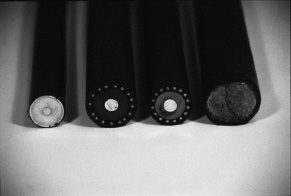Tom had flash burns to his face. Fortunately, he had been wearing safety glasses. What was left of his right arm had to be amputated above the elbow. He was in the hospital for almost four months. The medical care and physical therapy would continue for years.
Tom said that he and two experienced linemen were called out on trouble at two o’clock in the morning. A relatively new housing development was completely out of telephone service. Upon arrival at the development, they found a water company crew up to their waists in a water main break. The break was at the entrance to the long drive leading back to the development. The water company excavation was next to the trench line where the telephone company’s three hundred pair cable entered the development. The water company crew indicated it might be twelve hours before they would be done with their repair. Tom’s foreman assumed that the water main break or the repair excavation damaged the telephone cable. Since the nearest termination pedestal on the development side of the break was almost five hundred feet away, the decision was made to cut the telephone cable on the development side of the water problem and splice in a new cable around the water problem to the source terminal pole on the other side.
The foreman attached the transmitter of a cable tracer to the telephone cable at the development side pedestal. With a sensor to pick up the signal, Tom marked the location of the cable on the ground.
The telephone company maps showed the telephone cable had been installed in joint trench with the electric and cable TV cables. Since the NESC® in Rule 353D requires the power company high voltage cables to be installed at a minimum depth of 30 inches, the backhoe operator carefully dug down about 24 inches. So as not to damage the other cables, Tom and the backhoe operator dug the next 6 inches by hand. They found three jacketed cables: one about 0.9 inches in diameter and two cables about 1.3 inches in diameter. The cables were only a few inches apart. One of the larger cables was clearly marked with a lightning bolt and wording that indicated that it was a power cable. The NESC® in Rule 350G requires all direct buried communication cables and jacketed supply cables installed after January 1, 1996 to be marked with an identification symbol at spacing not more than 40 inches. The symbol for power cables is a lightning bolt. The symbol for communication cables is a telephone hand set. The marking is only required on one side of the cable.
Since one of the two large cables was marked and the cable TV cable is usually smaller than the telephone cable, the unmarked large cable was assumed to be the telephone cable. Since the transmitter of the cable tracer was still attached to the telephone cable at the pedestal, they tried to confirm their assumption. Because the cables were so close together, the sensor could not confirm their assumption. Tom was directed to cut the unmarked large cable . . .
Fortunately for Tom, his partners knew CPR and a paramedic team was only a few minutes away.

The investigation found that the two large cables were both power cables energized at 7200 Volts. The marking on the cable Tom cut was on the underside. The fault current that vaporized Tom’s cable cutter was about 9,000 Amps. The smaller cable was the cable TV cable. It was marked with a blue stripe facing to the side. The telephone cable they were looking for was next to the cable TV cable in undisturbed soil. It was only marked with the manufacturer’s name.
The NESC® in Rule 352 requires a horizontal minimum separation of 12 inches between direct buried supply and communication cables to permit access to and maintenance of either facility. The cables involved in the accident had been installed in “Random Separation.” “Random Separation,” supply and communication cables buried together at the same depth with no deliberate separation, is allowed by the NESC® in Rule 354 but only where the applicable requirements of Rule 354D are met and all parties are in agreement. The joint trench agreement between the telephone and power company did not mention “Random Separation.” The two companies’ construction standards only showed the NESC® 12-inch minimum. The work orders that directed the crews to install the cables spoke only of joint trench. Obviously, the crews who installed the cables were in agreement. But were the companies in agreement? The cable tracer equipment could not distinguish between cables installed so close together. The NESC® in Rule 423E requires positive identification before cutting into a cable. Did the people responsible for purchasing the tracer equipment know about the “random separation”? Had the crews been properly trained as to the hazards of random separation? Were the companies in agreement?

Even when the cable is marked, it’s a 50/50 chance that the marking faces down. If companies are going to do “Random Separation” to reduce trench expense, the employees must be properly trained and have the proper tools to deal with cables in close proximity.
Tom took the power company to court and Tom won. OSHA fined the telephone company. How much money did the companies really save going with “Random Separation”? [See photo 1]
Test yourself: Which of the four cables is the three hundred pair telephone cable? [See photo 2]
From left to right, the first cable is a cable TV cable (diameter 0.93″). The second cable is a 25kV class high-voltage cable (diameter 1.26″). The third cable is a 15kV class high-voltage cable (diameter 1.10″”). The fourth cable is a 300 pair telephone cable (diameter 1.30″”).











Find Us on Socials